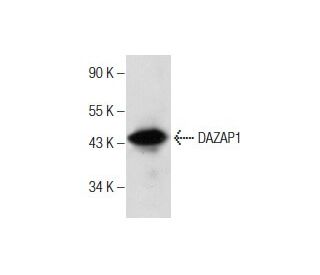


IMR-32 nuclear extract: sc-2148
- supplied in four vials, each containing 250 µg nuclear extract in 50 µl buffer
- provided in 20 mM HEPES (pH 7.9), 20% v/v glycerol, 0.1 M KCI, 0.2 mM EDTA, 0.5 mM PMSF and 0.5 mM DTT
- human nuclear extract; neuroblastoma cells
- suitable for use in Gel Shift and Western Blotting assays
- Extracts should be stored at -70°C and repeated freezing and thawing should be avoided.
- prepared by the method of Dignam et al., (1983) Nucleic Acids Res. 11: 1475
QUICK LINKS
SEE ALSO...
The IMR-32 nuclear extract is derived from the IMR-32 cell line, which is a neuroblastoma cell line established from a human infant. Neuroblastoma is a cancer that develops from nerve tissue, typically in infants and children. The IMR-32 cell line is widely used in neurobiology and cancer research because it retains many characteristics of neuronal cells, making it an excellent model for studying neural differentiation and neurobiological processes. The nuclear extract from IMR-32 cells is rich in nuclear proteins, including transcription factors, chromatin remodeling proteins, and other regulatory molecules that are crucial for understanding neuronal gene regulation and the cellular mechanisms underlying neuroblastoma. In research, the IMR-32 nuclear extract has been instrumental in studying the transcriptional and epigenetic landscapes that define neuroblastoma and in exploring the molecular pathways that influence neuronal development and malignancy. By examining these extracts, researchers can gain insights into the nuclear dynamics that occur during the transformation of normal neuronal cells into cancerous cells and during their response to various biochemical signals. This type of research is pivotal for comprehending the complex interplay of genetic and environmental factors that contribute to the development and progression of neuroblastoma, advancing our understanding of both fundamental neurobiology and the specific characteristics of this cancer type.
IMR-32 nuclear extract References:
- Transcriptional regulation of the human ADP-ribosylation factor 5 (ARF5) gene. | Lebeda, RA., et al. 1999. Biochim Biophys Acta. 1445: 314-20. PMID: 10366714
- PHOX2B regulates its own expression by a transcriptional auto-regulatory mechanism. | Cargnin, F., et al. 2005. J Biol Chem. 280: 37439-48. PMID: 16144830
- A haplotype variant of the human chromogranin A gene (CHGA) promoter increases CHGA expression and the risk for cardiometabolic disorders. | Subramanian, L., et al. 2017. J Biol Chem. 292: 13970-13985. PMID: 28667172
- Characterization of the human ADP-ribosylation factor 3 promoter. Transcriptional regulation of a TATA-less promoter. | Haun, RS., et al. 1993. J Biol Chem. 268: 8793-800. PMID: 8473323
Ordering Information
| Product Name | Catalog # | UNIT | Price | Qty | FAVORITES | |
IMR-32 nuclear extract | sc-2148 | 250 µg/0.05 ml | $160.00 |
